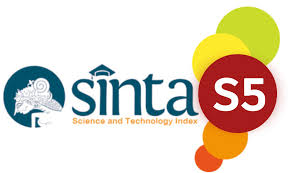Cengkeh Leave (Sizygium Aromatikum L.) A Natural Reppelent Of Salt Fish In Simuelue Islands
Keywords:
Repellent, Salt Fish, Cengkeh LeaveAbstract
Salt fish is a single fishery product produced by the Simeulue Islands community. Having a 280-kilometer coastline makes this district potentially able to produce and market salt fish in large quantities. The classic problem that still exists is the attack of flies on salty fish during the irrigation process. One solution to the problem is to add a natural repellent based on cranberry leaves to the product. It is supported by a cranberry plantation area of 15,141 hectares. The aim of this study was to look at the resistance of salted fish to the attack of flies during the irrigation process using a natural repellent based on cranberry leaf extract. This research model is a true experiment with the Post-test Only Control Group Design design. The analysis in this study is a repellent and anova test. The results of the study showed repellant concentrations of 20%, 40%, and 60% against successive flies attacks were 38%, 74%, and 89%. Anova analysis results showed a count value of 0,028976, lower than the alpha value of 0.050, which means natural repellents of cranberry leaves significantly influenced flies.
References
Abdel-Wahab, M. et al. (2020). Evaluation the efficacy of clove, sage and kiwifruit peels extracts as natural preservatives for fish fingers. Annals of Agricultural Sciences, 65(1), pp. 98–106. Available at: https://doi.org/10.1016/j.aoas.2020.06.002.
Alimi, D. et al. (2023). Toxicity, repellency, and anti-cholinesterase activities of bioactive molecules from clove buds Syzygium aromaticum L. as an ecological alternative in the search for control Hyalomma scupense (Acari: Ixodidae). Heliyon, 9(8). Available at: https://doi.org/10.1016/j.heliyon.2023.e18899.
AlvionitaDjau, S., Musa, N. and Lihawa, M. (2022). Uji Pestisida Nabati Daun Cengkeh (Syzygium Aromaticum L.) Untuk Mengendalikan Hama Kutu Daun (Aphid Sp.) Pada Tanaman Cabai Rawit (Capsicum frutescens L.). Agrotek: Jurnal Ilmiah Ilmu Pertanian, 6(2), pp. 39–46. Available at: https://doi.org/10.33096/agrotek.v6i2.234.
Astuti, L.P. et al. (2021). Pengaruh Konsentrasi Ektrak Daun Cengkeh Pada Diffuser Insect Repellent Terhadap Kepadatan Lalat Ditempat Pengolahan Telur Pt.X. 2(2), pp. 550–557. Available at: https://doi.org/10.34011/jks.v2i2.717.
Bili, R., Ballo, A. and Blegur, W.A. (2021). Uji Efektivitas Ekstrak Alkohol Daun Cengkeh (Syzigium aromaticum) Sebagai Repellent Semprot Terhadap Lalat Rumah (Musca domestica). Sciscitatio, 2(1), pp. 29–34. Available at: https://doi.org/10.21460/sciscitatio.2021.21.46.
Fitri, A. and Sukendra, D.M. (2020). Efektivitas Variasi Umpan Organik pada Eco Friendly Fly Trap sebagai Upaya Penurunan Populasi Lalat. Higeia (Journal of Public Health Research and Development), 4(2), pp. 448–459.
Gustina, M., Ali, H., & Kurniawan, Y. (2021). Efektivitas Ekstrak Daun Cengkeh (Syzigium Aromaticum) Dalam Mematikan Lalat Rumah (Musca Domestica). Journal of Nursing and Public Health, 9(1), 61–68
Huda, M., Rodhiansyah., & Ningsih, D. S. (2018). Efektivitas ekstrak bunga cengkeh (Eugenia aromatica) terhadap pertumbuhan bakteri Staphylococcus aureus. Jurnal Analis Kesehatan, 7(1), 710-716.
Indriasih, M., Chahaya, I., & Ashar, T. (2015). Pemanfaatan Ekstrak Daun Cengkeh (Syzigium aromaticum) Sebagai Repellent Nabati Dalam Mengurangi Jumlah Lalat Yang Hinggap Selama Proses Penjemuran Ikan Asin. Fakultas Kesehatan Masyarakat, Universitas Sumatera Utara, Medan
Lambiju, M. E., Wowor, M. P., & Leman, A. M. (2017). Uji daya hambat ekstrak daun cengkeh (Syzygium aromaticum (L.)) terhadap bakteri Enterococcus faecalis 5(1). Fakultas Kedokteran Universitas Sam Ratulangi Manado.
Martias, I. and Ajadit, N. (2020). Pengaruh Ekstrak Daun Cengkeh (Syzygium Aromaticum L.) Sebagai Repellent Terhadap Jumlah Lalat Yang Hinggap Selama Proses Penjemuran Ikan Asin Di Senggarang Tahun 2019. Jurnal Kesehatan Terpadu (Integrated Health Journal), 11(1), pp. 8–13. Available at: https://doi.org/10.32695/jkt.v11i1.53.
Mipa, J.P. (2020). Pemanfaatan Minyak Daun Cengkeh (Syzygium Aromatcum L.) Untuk Pengawetan Ikan. Media Eksakta, 16(2), pp. 113–121.
Mustanir & Rosnani. (2008). Isolasi Senyawa Bioaktif Penolak (Repellent) Nyamuk Dari Ekstrak Aseton Batang Tumbuhan Legundi (Vitex trifolia). Buletin Penelitian Tanaman Rempah dan Obat (BUL LITTRO), XIX(2) : 174 – 180. Universitas Syiah Kuala, Aceh, Indonesia.
Pahruddin, M., Aris Sandi, R. and Zubaidah, T. (2022). Perbedaan Efektivitas Rebusan Daun Cengkeh (Syzygium Aromaticum L) Dan Daun Pandan (Pandanus Amaryllifolius Roxb) Sebagai Pengusir Lalat Rumah (Musca domestica). Jurnal Sanitasi Profesional Indonesia, 3(1), pp. 16–22. Available at: https://doi.org/10.33088/jspi.v3i1.204.
Prabowo, E. (2022). Kabupaten Simeulue Dalam Angka 2022. 1(1).
Putri, A.K. et al. (2023). Edukasi Bahan Kimia Berbahaya untuk Pengawetan Ikan serta Pelatihan Pembuatan Ikan Asin Menggunakan Bahan yang Aman. Parahita : Jurnal Pengabdian kepada Masyarakat, 4(1), pp. 1–9. Available at: https://doi.org/10.25008/parahita.v4i1.97.
Rovita, F.M. and Wulandari, W. (2022). Formalin Content in Salted Fish in Traditional Market. Darussalam Nutrition Journal, 6(2), p. 115. Available at: https://doi.org/10.21111/dnj.v6i2.8266
Siti Tsaniyatul Miratis Sulthoniyah, Nandya Fitri Rachmawati, Cici Agustin, Susi Santi, Yoga Aditya. 2022. Karakteristik Terasi Bubuk dari Limbah Industri Udang dan Ikan Teri (Stolephorus sp.). Berkala Perikanan Terubuk Vol 50 No 1 .
Tomy Andri Zulpa, Bustari Hasan, Desmelati. 2013. Pengaruh Penambahan Garam Terhadap Karakteristik Dan Penerimaan Konsumer Fillet Asap Patin (Pangasius Hypophthalmus). Berkala Perikanan Terubuk. Hlm 58 – 65.
Downloads
Published
Issue
Section
License

This work is licensed under a Creative Commons Attribution-ShareAlike 4.0 International License.


